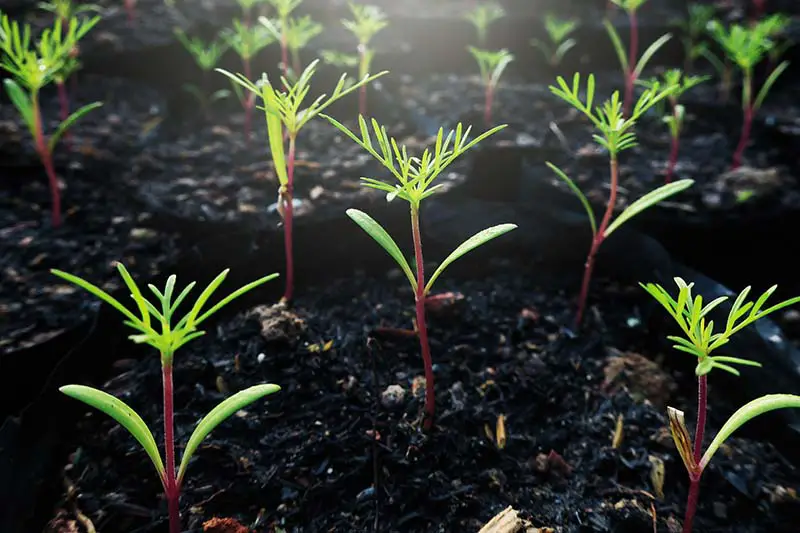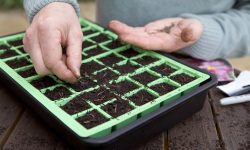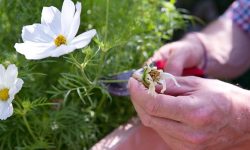Cosmos flowers are the perfect blend of beauty and simplicity. Their delicate petals, graceful stems, and bright colors make them a favorite among gardeners who want effortless charm. Yet, the secret to a long season of blooms lies in one crucial step—successful seed germination. Learning how to germinate cosmos seeds properly ensures strong, healthy plants that flower earlier and last longer. With a few easy techniques and the right timing, even beginners can grow cosmos that burst into color weeks ahead of schedule.
The germination process for cosmos seeds is straightforward but requires attention to detail. Temperature, light, moisture, and soil conditions all play an important role in whether your seeds sprout quickly and thrive. Whether you’re starting them indoors to get a head start or sowing them directly outdoors, understanding their needs will save time and effort. This guide will walk you through every step of how to germinate cosmos seeds easily, prevent common mistakes, and enjoy earlier, more abundant blooms in your garden this year.
Understanding Cosmos Seed Germination

Germination is the first and most vital stage in growing cosmos, setting the foundation for healthy and productive plants. It begins when the seed absorbs moisture and awakens from dormancy, triggering the growth of the embryonic root and shoot. Cosmos seeds are small, elongated, and lightweight, making them easy to handle but sensitive to environmental conditions. They require consistent warmth, moderate moisture, and loose, well-draining soil to germinate effectively. When these conditions are met, cosmos seeds typically sprout within seven to ten days, though cooler weather or excess moisture can delay the process.
The ideal temperature range for cosmos germination is between 68°F and 75°F (20°C–24°C). Within this range, the seeds can efficiently absorb water and activate internal enzymes that drive early growth. Light is not essential for germination, but it helps guide seedlings once they emerge. Too much darkness or cold soil can cause seeds to rot before sprouting. Proper airflow and moderate humidity are also critical in preventing fungal diseases, such as damping-off, which can quickly destroy young seedlings. Maintaining a balance between warmth and air circulation helps ensure strong, steady development.
Understanding this early stage helps gardeners make smart choices about when and where to start cosmos seeds. Those in colder regions can begin seeds indoors under controlled conditions, while gardeners in warmer climates can sow them directly outdoors once frost danger has passed. By focusing on soil quality, temperature stability, and moisture control, you create the perfect environment for your cosmos to sprout quickly and grow into thriving plants that bloom weeks earlier than usual.
Preparing Seeds and Soil for Successful Germination
Before you plant cosmos seeds, proper preparation ensures faster germination and stronger seedlings. Start by selecting fresh, high-quality seeds, as older ones tend to have lower germination rates. Although cosmos seeds don’t require pre-soaking, doing so for a few hours in warm water can soften the seed coat and speed up sprouting. If you’re using harvested seeds from last season, check that they are dry and free from mold before sowing. Preparation also includes choosing the right growing medium. Cosmos prefer light, well-draining soil with minimal organic matter. Overly rich or compacted soil can hinder root development and cause damping-off in seedlings.
Mixing your soil with sand or perlite helps improve aeration and drainage, creating a more suitable environment for germination. A simple potting mix made from peat, compost, and coarse sand works perfectly for both indoor and outdoor sowing. Fill seed trays, pots, or garden beds with the mix and lightly moisten it before planting. The soil should feel damp but not wet—excess moisture can suffocate seeds. Cosmos seeds should be sown very shallowly, just barely covered with soil, since they need access to light for proper development once germination begins.
If starting seeds indoors, choose small containers with drainage holes and place them in a warm, bright location. Maintaining steady warmth is crucial during the first week, as fluctuating temperatures can slow down sprouting. Once the seedlings appear, move them to a sunny window or under grow lights to promote strong, upright growth. Preparing both your soil and seeds with care sets the stage for quick, healthy germination and gives your cosmos the best possible start toward early, abundant blooms.
Indoor Germination Method (Step-by-Step Guide)
Starting cosmos seeds indoors gives you a valuable head start on the growing season, especially if you live in a region with late frosts or short summers. Begin about four to six weeks before your last expected frost date. Fill seed trays or small pots with a light, well-draining mix made of peat moss, compost, and perlite. Gently press the cosmos seeds into the surface of the soil, covering them with no more than a thin layer of mix—just enough to hold them in place. The seeds need warmth to sprout, so maintain a temperature between 70°F and 75°F (21°C–24°C). Keeping the trays in a warm room or using a seed heating mat ensures consistent warmth for quicker germination.
Light moisture is key during this stage. Use a spray bottle to mist the soil lightly whenever it begins to dry out, but avoid overwatering, as too much moisture can lead to fungal diseases. Covering the trays with a plastic dome or clear film helps retain humidity while still allowing light to pass through. Once seedlings begin to emerge, usually within a week, remove the cover and place them in a bright location. A sunny window or grow lights placed a few inches above the seedlings will keep them strong and prevent stretching. Rotate the trays daily for even light exposure and growth.
As the seedlings grow taller and develop two or more sets of true leaves, reduce watering slightly and allow the top of the soil to dry out between misting. This encourages root strength and helps prepare the plants for outdoor conditions. About a week before transplanting, begin hardening them off by exposing them to outdoor conditions for a few hours each day, gradually increasing the time. Starting cosmos indoors allows you to transplant vigorous, healthy seedlings that bloom earlier and more profusely once they reach the garden.
Direct Outdoor Sowing Method for Cosmos Seeds
Sowing cosmos seeds directly outdoors is one of the easiest ways to grow these cheerful flowers, especially in regions with mild climates and long summers. This method eliminates the need for transplanting and allows the seedlings to adapt naturally to outdoor conditions from the start. Begin planting after the last frost has passed and the soil has warmed to at least 65°F (18°C). Choose a sunny spot with well-draining soil, as cosmos thrive in bright light and dry conditions. Gently rake the soil surface to loosen it, then scatter the seeds evenly across the area. Cover them lightly with a thin layer of soil—no more than a quarter of an inch—since cosmos seeds need some light to germinate properly.
Water the soil gently after sowing to settle the seeds without washing them away. Keep the area moist but never soggy during the first week, as excessive moisture can cause seeds to rot. Within seven to ten days, small green shoots should begin to emerge. Once the seedlings reach about three inches tall, thin them out to ensure proper spacing—about 12 to 18 inches apart for compact varieties and up to 24 inches for taller ones. This spacing allows airflow between plants, which helps prevent mildew and encourages strong, upright growth. If you’re planting in rows, leaving room for easy access makes weeding and watering much simpler.
As the seedlings grow, water sparingly and avoid using rich fertilizer, as too many nutrients can lead to leafy plants with fewer flowers. A layer of mulch around the base helps conserve moisture and reduce weed competition. Direct-sown cosmos typically catch up quickly to those started indoors, often blooming just a few weeks later. This method produces hardy, well-adapted plants that require minimal care but deliver maximum color throughout the summer. With a little patience and the right soil conditions, your cosmos will thrive outdoors with stunning, natural beauty.
Ideal Conditions for Fast and Healthy Germination
For cosmos seeds to germinate quickly and grow into strong, healthy plants, maintaining the right environmental conditions is essential. Temperature is the most critical factor—cosmos seeds sprout best between 70°F and 75°F (21°C–24°C). If the soil is too cold, germination will slow or fail completely. Indoors, a seed heating mat helps maintain even warmth, while outdoors, it’s best to wait until the soil feels comfortably warm to the touch. Light is also important; while cosmos seeds can germinate in partial darkness, they grow sturdier and more evenly under bright, indirect light once seedlings appear. Too little light will cause them to stretch and weaken early on.
Moisture must be balanced carefully to ensure healthy germination. The soil should remain consistently damp but never saturated. Overwatering suffocates the seeds and increases the risk of fungal diseases such as damping-off, which can destroy seedlings within days. To avoid this, use a fine mist spray rather than a heavy stream of water, and make sure your containers or garden bed have good drainage. Air circulation also supports healthy growth and prevents mold from forming on the soil surface. In humid environments, gentle airflow from a small fan can make a noticeable difference.
Finally, the quality of the soil plays a significant role in seedling success. Cosmos prefer slightly lean, loose soil with a pH between 6.0 and 7.0. Overly rich soil with high nitrogen levels encourages excessive leaf growth and delays flowering. Mixing in a little sand or perlite helps improve aeration, allowing roots to expand freely. With warm temperatures, bright light, and well-drained soil, cosmos seeds germinate swiftly—often within a week—and quickly develop into vigorous plants ready to fill your garden with early, abundant blooms.
Caring for Cosmos Seedlings After Germination
Light and Temperature
Once cosmos seedlings have germinated, proper light and temperature management are essential for healthy growth. Cosmos are sun-loving plants, and their seedlings need plenty of bright light to grow strong and compact. Indoors, place them near a south-facing window or under grow lights for 12 to 14 hours daily. Without sufficient light, seedlings may stretch and become weak, making them prone to bending or breaking after transplanting. Keep the temperature steady between 68°F and 75°F (20°C–24°C) to promote strong root and leaf development. Avoid placing them in drafty or overly hot locations, as sudden changes can stress the plants and slow growth.
Light and temperature also influence how quickly the seedlings mature. Too much heat can cause rapid but fragile growth, while cool temperatures delay development. Maintaining a balance ensures the seedlings stay sturdy and resilient. Once they produce several true leaves, you can gradually expose them to cooler nighttime temperatures to strengthen their stems. If grown indoors, lightly brush your hand over the tops of the seedlings daily to simulate outdoor movement—this helps them grow thicker, more stable stems that can handle outdoor wind once transplanted.
Watering and Moisture Control
Consistent moisture is vital for young cosmos seedlings, but overwatering is one of the most common causes of failure. The soil should remain slightly damp, not soaked. Watering with a spray bottle or a narrow-spout can helps distribute moisture evenly without disturbing delicate roots. When watering from the top, aim for the base of the seedlings to prevent wetting the leaves, which can lead to fungal diseases. It’s best to water in the morning so any excess moisture has time to evaporate during the day, keeping the plants dry overnight.
Good drainage is just as important as watering consistency. If the containers lack drainage holes, water can accumulate at the bottom, suffocating roots and causing rot. To maintain balance, allow the top layer of soil to dry slightly before watering again. For outdoor seedlings, mulching helps retain soil moisture while preventing weed competition. Over time, proper watering practices train cosmos roots to grow deeper, making the plants more drought-tolerant and capable of thriving with minimal maintenance once transplanted into the garden.
Air Circulation and Spacing
Air circulation is often overlooked but is critical for keeping cosmos seedlings healthy and disease-free. Crowded seedlings restrict airflow, creating a humid environment where mold and fungus can thrive. To prevent this, thin the seedlings once they have grown a few inches tall, leaving about two inches between each one in trays or pots. This spacing allows air to flow freely and helps each seedling receive adequate light. Gentle air movement also strengthens stems, preparing the plants for outdoor conditions. Indoors, using a small fan on a low setting for a few hours daily can greatly improve air quality.
Proper spacing and airflow reduce the risk of damping-off, a common fungal disease that kills young seedlings at the base. It also minimizes competition for nutrients and water. When the seedlings begin to crowd again, it’s time to transplant them into larger pots or the garden. By maintaining good air circulation and careful spacing throughout their growth, cosmos seedlings develop strong, upright stems and healthy leaves, ensuring they transition smoothly into vigorous flowering plants ready for transplanting.
Transplanting Cosmos Seedlings into the Garden
Transplanting cosmos seedlings at the right time ensures strong establishment and early blooming. The best time to transplant is after the danger of frost has completely passed and the soil has warmed to at least 65°F (18°C). Cosmos are sensitive to cold, and even a light frost can damage young plants. Before moving them outdoors, begin hardening them off by gradually introducing them to outside conditions. Start by placing the seedlings in a sheltered, partially shaded spot for a few hours each day, increasing their outdoor exposure over a week. This process toughens the stems and helps the plants adjust to fluctuating temperatures and sunlight. Skipping this step often leads to transplant shock, which can delay flowering or stunt growth.
Choose a sunny location with well-draining soil, as cosmos thrive in full light and slightly dry conditions. Avoid overly rich or compacted soil, which encourages leafy growth at the expense of blooms. To transplant, dig holes just deep enough to accommodate the root ball, spacing plants about 12 to 18 inches apart for smaller varieties and up to 24 inches for taller ones. Handle the seedlings gently by their leaves, not the stems, to prevent damage. Once in the ground, press the soil lightly around the roots and water thoroughly to settle them in place. A thin layer of mulch helps retain moisture without suffocating the roots.
During the first week after transplanting, keep the soil slightly moist but not wet to help the roots establish. Once the plants adapt to their new environment, reduce watering to encourage deep root growth and resilience. Within a few weeks, the cosmos will begin producing lush foliage, soon followed by buds and blooms. Proper transplanting ensures healthy, vigorous plants that reward you with early, abundant flowers throughout the growing season, turning your garden into a vibrant sea of color.
Common Mistakes to Avoid During Germination
Overwatering the Seeds
One of the most frequent mistakes when germinating cosmos seeds is overwatering. Many gardeners believe that constant moisture helps seeds sprout faster, but too much water can suffocate them. When the soil stays saturated, oxygen cannot reach the seeds, and they begin to rot before germinating. Overwatering also creates the perfect environment for fungal infections such as damping-off, which can kill young seedlings within days. Cosmos seeds need evenly moist soil, not soggy conditions, so it’s best to water sparingly with a mist spray to maintain balance.
The key is to keep the soil lightly damp until seedlings appear. Once the first shoots emerge, reduce watering frequency and allow the top layer of soil to dry slightly between sessions. This encourages stronger root development and reduces disease risk. Ensuring proper drainage in trays or pots also prevents standing water at the base. By learning to water correctly, you can avoid the biggest threat to successful germination and help your cosmos seeds grow into healthy, thriving plants ready for transplanting.
Planting Seeds Too Deep
Another common mistake is sowing cosmos seeds too deeply in the soil. These seeds are very small and require light to germinate effectively. When buried too far, they struggle to reach the surface, leading to slow, uneven, or failed germination. The ideal planting depth is just below the surface—barely covered with a thin layer of soil or fine vermiculite. This allows both warmth and light to reach the seed easily, triggering faster sprouting.
If seeds are sown too deep, they may also become waterlogged and susceptible to decay. To fix this, gently press seeds into the surface rather than burying them. Keeping the top layer of soil moist ensures that the seed coat softens and the sprout can emerge quickly. A light covering is sufficient to anchor the seed while still giving it access to air and light. Proper planting depth not only improves germination rates but also produces sturdier, more uniform seedlings that develop into strong, blooming cosmos plants.
Ignoring Temperature and Light Requirements
Temperature and light are two of the most critical factors for successful germination, yet they are often overlooked. Cosmos seeds need warmth—ideally between 70°F and 75°F (21°C–24°C)—to germinate properly. If the soil is too cold, germination slows dramatically, and many seeds may remain dormant. Placing seed trays in a drafty or shaded area can prevent sprouting entirely. Light is equally important once seedlings appear. Without sufficient brightness, young plants become leggy and weak, unable to support themselves when transplanted.
To avoid these problems, always start seeds in a warm, bright location. Indoors, use grow lights or a sunny windowsill that receives at least six hours of light daily. Outdoors, choose a sunny garden bed free from shade cast by trees or buildings. Maintaining steady warmth with good light exposure encourages fast, even germination and helps seedlings grow strong and healthy. By managing temperature and light carefully, you give your cosmos the best foundation for a season of vibrant, early blooms.
How to Speed Up Cosmos Seed Germination Naturally
Speeding up cosmos seed germination naturally begins with creating the ideal conditions that trigger quick sprouting. Start by using fresh, high-quality seeds, as older ones tend to lose viability. Before planting, soak the seeds in lukewarm water for about six to eight hours to soften their outer coating. This process helps moisture penetrate more easily, awakening the dormant embryo inside. After soaking, let the seeds dry briefly before sowing them in moist, well-draining soil. Using a light, airy potting mix with sand or perlite improves oxygen flow around the seeds, encouraging faster root growth. Keeping the temperature stable between 70°F and 75°F (21°C–24°C) provides the warmth needed for rapid germination.
Moisture balance is another crucial element in speeding up sprouting. The soil should stay consistently damp but never waterlogged. A fine mist sprayer works best for maintaining gentle, even moisture. Covering seed trays with a transparent plastic lid or film traps humidity, creating a greenhouse effect that accelerates germination. However, remove the cover once seedlings appear to prevent mold growth. Providing gentle airflow around the trays improves oxygen levels and keeps diseases away. For indoor setups, placing the trays under bright, indirect light ensures healthy development once seedlings emerge.
Finally, positioning plays a subtle but powerful role in early germination. Placing seed trays near a warm, bright window or on a seed heating mat mimics natural spring warmth and encourages faster sprouting. Avoid fertilizing during this stage, as too many nutrients can harm tender roots. Instead, focus on maintaining warmth, moisture, and light balance. Under optimal conditions, cosmos seeds can germinate in as little as five to seven days. This natural, low-effort approach produces robust seedlings that establish quickly and bloom earlier—giving your garden a head start on a season filled with radiant, carefree color.
Post-Germination Care and Early Growth Tips
Once cosmos seeds have successfully germinated, the next few weeks are critical for shaping strong, resilient plants. During this early growth stage, light, temperature, and moisture must remain steady. Young seedlings need plenty of bright, indirect sunlight—at least six hours per day—to prevent them from stretching toward the light. If grown indoors, place them near a sunny window or use grow lights set a few inches above the plants. Maintaining temperatures between 68°F and 75°F (20°C–24°C) supports steady root and leaf development. Avoid sudden temperature changes or drafts, as these can stress seedlings and slow growth. Consistent warmth and light create a stable environment that encourages the plants to grow thick stems and lush foliage.
Moisture control is equally important at this stage. The soil should remain slightly damp but not wet, as overwatering can lead to root rot or fungal diseases. Watering from the base or using a fine mist helps keep the soil evenly moist without disturbing young roots. Once seedlings develop two to three sets of true leaves, begin thinning them out to avoid overcrowding, leaving the strongest ones to continue growing. This step allows proper air circulation and ensures that each seedling has access to enough space, light, and nutrients. If you plan to transplant them outdoors, begin hardening them off gradually by exposing them to outdoor conditions for a few hours each day.
Feeding also plays a role in early development. Cosmos seedlings do not need heavy fertilization; a light dose of diluted, balanced liquid fertilizer every two weeks is enough. Too much fertilizer can lead to excessive foliage and delayed flowering. Focus instead on promoting balanced growth and strong roots. As the plants grow taller, pinch the tips gently to encourage branching, which leads to more blooms later. By providing consistent light, moisture, and care, you’ll nurture cosmos seedlings that are robust, adaptable, and ready to thrive in your garden long before the season reaches its peak.
FAQs About Germinating Cosmos Seeds
How long does it take for cosmos seeds to germinate?
Cosmos seeds typically germinate within seven to ten days under warm, moist conditions. When temperatures stay between 70°F and 75°F (21°C–24°C), sprouts can appear even sooner. Consistent moisture, light airflow, and proper soil drainage are essential for quick, healthy germination and strong seedling development.
Do cosmos seeds need light to germinate?
Cosmos seeds germinate best when they’re lightly covered or pressed into the soil surface, allowing indirect light to reach them. While they don’t need full light to sprout, exposure to brightness helps guide seedlings once they emerge. Planting them too deep can delay or prevent germination entirely.
Should I soak cosmos seeds before planting?
Soaking cosmos seeds for six to eight hours before planting helps soften their seed coat and speeds up moisture absorption. It’s not mandatory, but it often results in faster germination. After soaking, let them dry briefly, then plant in damp, well-draining soil for best results.
Can I germinate cosmos seeds indoors?
Yes, cosmos seeds germinate very well indoors. Start them four to six weeks before the last frost in trays or small pots with a light potting mix. Keep them warm, moist, and under bright light. Once seedlings grow several true leaves, gradually acclimate them before transplanting outside.
Why didn’t my cosmos seeds sprout?
Several factors can cause poor germination, including cold soil, overwatering, or planting seeds too deeply. Old or poor-quality seeds also reduce success rates. Ensure warm temperatures, moderate moisture, and good airflow. Using fresh seeds in well-draining soil under consistent warmth usually solves the problem.
Conclusion
Germinating cosmos seeds is a simple yet rewarding process that marks the beginning of a vibrant, flower-filled garden. With just the right warmth, moisture, and light, these seeds awaken quickly and grow into strong, graceful plants. A little patience and consistent care can bring early, abundant blooms that fill your garden with effortless beauty. By mastering the basics of germination and nurturing seedlings with gentle attention, you set the stage for months of color and joy. Every tiny seed you plant becomes a promise of life, transforming your space into a living celebration of summer’s brilliance.






